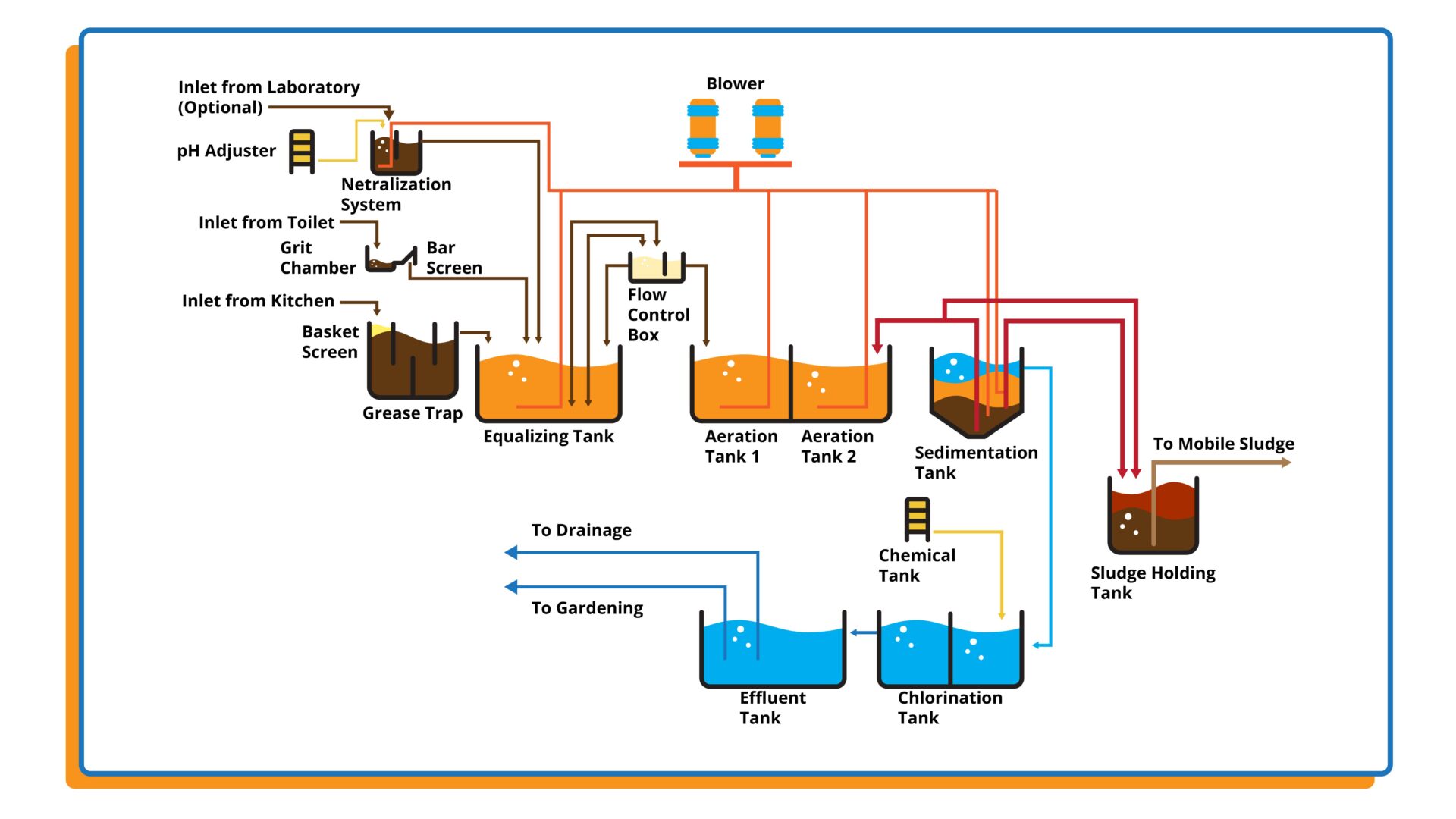Sustainable Practice of Wastewater Treatment at BINUS UNIVERSITY
Jakarta, 24 October—The rapid growth of higher education within the urban area significantly affects water quality due to the influx of domestic and industrial waste.
BINUS University, an educational institution with over 55,000 students spread across 11 campuses in Jakarta, Bekasi, Tangerang, Bandung, Semarang, and Malang, is responsible for managing the wastewater generated in accordance with Law No. 32 of 2009 related to environmental protection and management.

(Photo Credit: Mufti Warits)
Adequate wastewater treatment is essential for environmental protection and human health. As water serves as a fundamental source of life, we must utilize it responsibly and ensure its purity to secure water resources for future generations.
Committed to environmental stewardship and supporting the Sustainable Development Goals (SDGs), BINUS University has built a Sewage Treatment Plan (STP), referred as IPAL, to process liquid waste categorized as organic, inorganic, and hazardous (B3) waste produced from campus activities before releasing it into the city’s water drainage system coming from our laboratories, cafeterias, and restrooms.

(Photo Credit: Mufti Warits)
In examining the wastewater management system, Mr. Risan, the Maintenance Engineering Section Head at BINUS @Alam Sutera, explained that, “The dirty water from the toilets and the canteen, along with the wastewater from the laboratories, will be processed through different channels. This is because the laboratory wastewater often contains hazardous chemicals that can contaminate the soil, water, and air if not handled separately and properly.”
The STP utilizes an extended aeration system at our Alam Sutera Campus. Based on the Wastewater Technology Fact Sheet Package Plants published by the United States Environmental Protection Agency in 2000, this method applies a biological treatment process using aerobic bacteria—microorganisms that require oxygen to survive—to decompose organic particles and other contaminants in wastewater.
Flowchart: Sewage Treatment Plant—Extended Aeration Process

(Flowchart Illustration: Mufti Warits/Adopted from: Biosant Extended Aeration)
The flow diagram above illustrates the extended aeration process in the STP. First, toilet wastewater is routed to the influent chamber to filter out heavier particles and solids. Meanwhile, wastewater from the canteen, which typically contains oils and fats, is directed to a grease trap to capture these greasy and oil substances, preventing pipe blockages and ensuring they do not interfere with the main treatment process.
Following this preliminary filtration, canteen and restroom wastewater flow into the equalizing tank for mixing before undergoing treatment in the aeration tank. A biological treatment occurs by adding microorganisms, specifically aerobic bacteria aided by oxygen supplied via a blower, to reduce odors and effectively lower Chemical Oxygen Demand (COD) and ammonia levels.

(Photo Credit: Mufti Warits)
In this subsequent phase, the water processed in the aeration tank flows into the clarifier tank, also known as the sedimentation tank, to isolate solid materials from the liquid. These solids will accumulate at the bottom of the tank and later be funneled into the sludge tank, containing the final sludge residue.
Once filtered, the water flows into the chlorination tank, where it is treated with chlorine to kill harmful organisms such as viruses and bacteria, including pathogenic microbes known to cause diarrhea, as explained by Ms. Nurul Laily Hidayati, S.Si.T., M.Kes, staff at the Kulon Progo Health Service Office.
During the decomposition process, it is essential to keep the pH level (Power of Hydrogen) within the range of 6-9 (considered neutral), as outlined in the domestic wastewater quality standards established by the Minister of Environment and Forestry in regulation No. P.68/Menlhk/Setjen/Kum.1/8/2016.

(Photo Credit: Mufti Warits)
The pH value indicates the acidity or alkalinity of a liquid. If the pH of the water is less than 6, this signifies a high level of acidity, which suggests the presence of corrosive substances and heavy metals that can pose health risks and cause corrosion in piping systems. According to Dr. Verury Verona Handayani in her 2019 article on the Halodoc website, water with an excessively high pH, above 9, can lead to the risk of alkalosis when consumed, characterized by low calcium levels in the body, and may result in bone damage.
“Results from the Building Management team’s examination of the treated wastewater show that the pH fluctuates between 4 and 5.6, reflecting a high level of acidity. To address this problem, the BM team usually increases the concentration of aerobic bacteria to break down carbon-containing organic materials and boost the oxygen levels in the water, contributing to reducing its acidity,” adds Mr. Risan.

(Photo Credit: Mufti Warits)
At the final stage, the treated water is transferred to the effluent tank, which can either flow into the municipal drainage system or serve as a water source for irrigation in the campus gardens.
The team also addressed some challenges at the site, including unbalanced pH levels and limited water quality assessment; therefore, a robust monitoring system and evaluation will help the wastewater adhere to the quality standards established by the government for environmental protection before it is released back into the city’s drainage system.

(Photo Credit: Mufti Warits)
Lastly, BINUS University is firmly committed to creating a cleaner world through effective water management. The Building Management team at our Alam Sutera campus operates around the clock, ensuring that robust systems are in place and championing the importance of responsible water use.
(Words by: Mita Adhisti/Editor: Hamzah Ramadhan)




Comments :